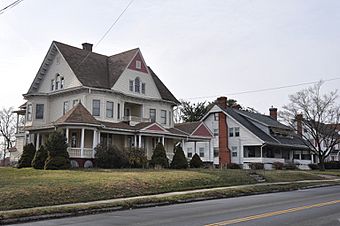Fairfield Avenue Historic District (Hartford, Connecticut) facts for kids
Quick facts for kids |
|
|
Fairfield Avenue Historic District
|
|
 |
|
| Location | Fairfield Ave. between Trinity College and Cedar Crest Cemetery, Hartford, Connecticut |
|---|---|
| Area | 42.8 acres (17.3 ha) |
| Architectural style | Colonial Revival, Queen Anne, Ranch |
| NRHP reference No. | 11000435 |
| Added to NRHP | July 19, 2011 |
The Fairfield Avenue Historic District is a special area in southern Hartford, Connecticut. It stretches from Trinity College in the north to Cedar Hill Cemetery in the south. This street shows how the city grew between about 1890 and 1930. During this time, streetcars helped the area develop quickly. This district was added to the National Register of Historic Places in 1984.
Exploring Fairfield Avenue's History
Fairfield Avenue is a very old road in Hartford. It runs south along a high area from downtown Hartford. This path generally follows the Connecticut River.
How Fairfield Avenue Grew
Until the mid-1800s, this area was mostly farmland. It had open spaces with great views of the river valley. These views made the area very appealing. After the American Civil War, wealthy people from the city wanted to build large country homes here.
George Fairfield was one of the first to build a grand house. He was a former leader at the Colt Armory. In 1866, he built a beautiful house at 160 Fairfield Avenue. George Fairfield helped shape how the area grew. By 1870, the street was named after him.
More fancy homes were built along the avenue. But the biggest change happened in 1890. That's when streetcar service started. This made the area much easier to reach and led to even more building.
What You'll See in the District
The historic district starts near the campus of Trinity College and Hyland Park. It ends near Cedar Hill Cemetery. However, it does not include the college or the cemetery themselves.
Most of the buildings in the district are homes. Hyland Park is the largest area that isn't a home. There is also one church, the Memorial Baptist Church. This church is one of seven buildings in the district built by Newton Clark. He was a very active builder in the area. Most of the houses on the street were built between 1890 and 1930. They show the popular building styles from that time.



